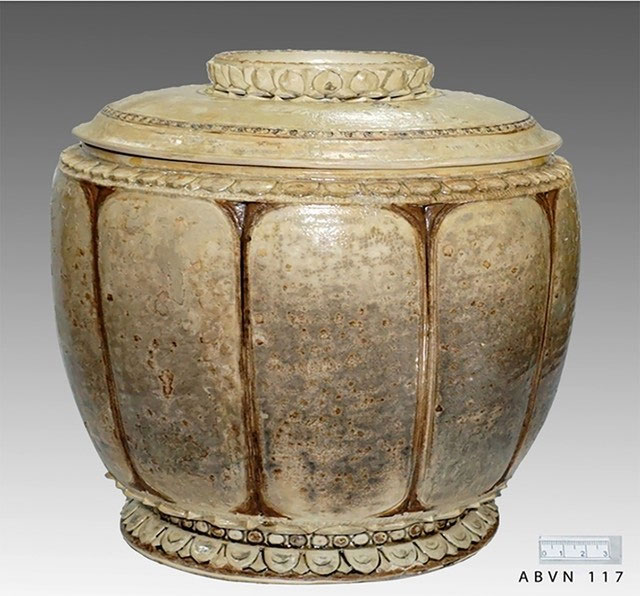Brown flower ceramic vase - Buddhist treasure of the Ly Dynasty
Brown flower ceramic vase from the 11th and 12th centuries shaped like a lotus flower, identified as a relic worship box.
The national treasure was recognized by the Prime Minister in January and is currently in the An Bien collection of Mr. Tran Dinh Thang in Hai Phong City.
Mr. Thang said he has owned the ceramic vase since the 1980s, through advice from a Japanese collector. He affirmed that the vase is a unique artifact, with the crafting method, shape, and motifs reflecting all the cultural nuances of the dynasty, and at the same time carrying intangible cultural heritage value.

The artifact has a mouth diameter of 22.7 cm and a bottom of 18 cm. (Photo: Department of Cultural Heritage).
The treasure is also known as a brown flower ceramic tureen of the Ly Dynasty or a relic worship box. The bottle is 25.5 cm high, weighs 2.7 kg, and consists of two separate parts: the lid and the body, which are fitted together. The lid is flat, spherical, the mouth is slightly flared, the high knob has a blooming lotus pattern with three layers of petals and round beads like white and brown beads alternating between two parallel raised lines. The shoulders are carved with evenly embossed lotus petals.
The body is cylindrical in shape, with curved walls, wide at the top, tapered at the bottom. The body is divided into 10 evenly spaced rectangular cells around the body, with rounded corners like a 10-petaled lotus. The base is shaped like a floating lotus placed on a round surface, with a wooden bottom, creating stability.
The vase is made from white clay, kaolin covered with ivory white enamel and brown enamel bowl. When crafting, the craftsman combines mold printing, claw shaping, carving and sculpting to create patterns on a turntable, then puts it in a furnace with temperatures around 1,200 degrees Celsius.
According to documents from the Department of Cultural Heritage, the product has uniform maturity in both the soil, glaze, and color, with few warping or blistering defects. The color of the base enamel is ivory because the bone clay has not been thoroughly filtered. Brown enamel is created from stone ore materials mined on site, then ground into powder and mixed with a few other additives including ocher and iron oxide. When heated at high temperatures, it will create levels of brown color such as coffee and chestnut.
Treasure records of the Department of Cultural Heritage show that ceramic tureens not only have high artistic value but are also used to perform Buddhist rituals during the Ly Dynasty.
Through the color of ivory enamel and brown enamel, the lotus petal shape shows that the tureen dates back to the 11th-12th centuries, collected in Vietnam. According to documents from the National Museum of History, Buddhism was the main theme on brown-flowered ceramics from the Ly to Tran dynasties. Among them, lotus flowers and variations of lotus appear a lot, accounting for the largest proportion.
In addition, based on the shape and theme of decorative patterns including lotus petals, small circles, and parallel lines on the tureen, many researchers of archeology, fine arts, and Vietnamese cultural heritage have identified Artifacts belonging to the dynasty's Buddhist service line, are dharma treasures to place relics and dharma bodies for worship in stupas.
The Department of Cultural Heritage affirms that the artifacts are imbued with the indigenous nuances of the Vietnamese people, carrying the cultural and political soul of the monarchy of the Ly Dynasty, when Buddhism became the state religion. The detail of the vase's body divided into 10 segments represents the ancient Eastern cultural concept: "Nine directions of heaven, 10 directions of Buddha" , meaning that every space has Buddha. Treasure profile quoted according to Mahayana Buddhism: "If sentient beings have Buddha in their minds, they will live in awareness and mindfulness, and Buddha will protect them and not fall into suffering."
Besides, this is one of the typical representatives of the development of Ly Dynasty ceramic art , reflecting the ideological values and aesthetic level of the era, as well as showing religious life. . Scholars say that only when society is peaceful and developed, can ceramic artists who use Buddhism as spiritual nourishment be able to create excellent products rich in cultural beauty.
- Use an antique flower vase of 860,000 USD to block objects for 36 years
- Preserving flowers
- 'Treasures of the Qing Dynasty' were once abandoned in the corner of the kitchen, selling for more than 41 billion dong
- Decode the exquisite ceramic vase used to feed unsuspecting horror animals
- Thanh's ceramic bowl was expected to break the auction record
- Pottery pots over 1,500 years old under the Huong River
- Discovered a 2700-year-old treasure at the holy site of Jerusalem
- Discovering ruins of Tran dynasty Buddhist architecture
- Found 'treasure' containing many Roman antiques in Spain
- Washing flower vases will help fresh flowers longer
- The mysterious ceramic vase is actually a 900-year-old 'deadly weapon'
- Discover treasure 600 kg of coins in Spanish park
 Discovered an ancient centipede fossil 99 million years old
Discovered an ancient centipede fossil 99 million years old Discovered bat-like dinosaurs in China
Discovered bat-like dinosaurs in China Discovered a 200-year-old bronze cannon of the coast
Discovered a 200-year-old bronze cannon of the coast Discover 305 million-year-old spider fossils
Discover 305 million-year-old spider fossils